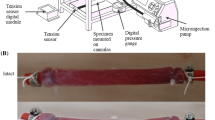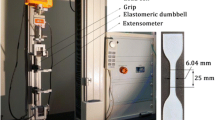Abstract
Accurate material properties of tissues are a key factor for the improvement of medical procedures and treatments. Experimental data are essential in order to formulate and validate a useful constitutive model for predicting the mechanical behavior of tissues in these procedures. This study develops a comprehensive experimental protocol at multiple length scale levels in order to obtain stress–strain curves for esophagus tissue. This paper compares two different models: a conventional, non-linear elastic model, and a microcontinuum model based on fiber rearrangement. Also, a detailed description of the experimental procedure is provided. While the focus was on esophageal tissues, the experimental procedure and microcontinuum are considered widely applicable to other samples of soft tissue.






Similar content being viewed by others
References
Altenbach, H., and V. A. Eremeyev (eds.). Generalized Continua from the Theory to Engineering Applications (No. 541). New York: Springer, 2013.
Bass, C. R., K. Darvish, B. Bush, J. R. Crandall, S. C. M. Srinivisan, C. Tribble, S. Fisher, and L. Tourret. Material properties for modeling traumatic aortic rupture. Stapp Car Crass J. 45:143–160, 2001.
Braess, D. Finite Elements: Theory, Fast Solvers and Applications in Solid Mechanics. Cambridge: Cambridge University Press, pp. 254–255, 1998.
Cosserat, E., and F. Cosserat. Theorie des Corps Deformables. Paris: Hermann, 1909.
Deng, S. X., J. Tomioka, J. C. Debes, and Y. C. Fung. New experiments on shear modulus of elasticity of arteries. Am. J. Physiol. Heart Circ. Physiol. 266(1):H1–H10, 1994.
Dobrin, P. B., and J. M. Doyle. Vascular smooth muscle and the anisotropy of dog carotid artery. Circ. Res. 1970(27):105–119, 1970.
Eberl, C., R. Thompson, D. Gianola; and Group of Kevin J. Hemker, John Hopkins University. http://www.mathworks.es/matlabcentral/fileexchange/12456-digital-image-correlation-and-tracking-example-files-and-slides, 2006.
Eringen, A. C. Microcontinuum Field Theories: Volume 1, Foundations and Solids. New York: Springer, 1999. ISBN 0387986200.
Eringen, A. C., and E. S. Suhubi. Non-linear theory of simple micro-elastic solids. Int. J. Eng. Sci. 2:189–203, 1964.
Fan, Y., H. Gregersen, and G. Kassab. A two-layered mechanical model of the rat esophagus. Experiment and theory. Biomed. Eng. Online 3:40, 2004.
Goda, I., M. Assidi, S. Belouettar, and J. F. Ganghoffer. A micropolar constitutive model of cancellous bone from discrete homogenization. J. Mech. Behav. Biomed. Mater. 16:87–108, 2012.
Lu, X., and H. Gregersen. Regional distribution of axial strain and circumferential residual strain in the layered rabbit oesophagus. J. Biomech. 34:225–233, 2001.
Maugin, G. A., and A. Miled. Solitary Waves in Micropolar Elastic Crystals. Int. J. Eng. Sci. 9:1477–1499, 1986.
Natali, A. N., E. L. Carniela, and H. Gregersen. Biomechanical behaviour of oesophageal tissues: material and structural configuration, experimental data and constitutive analysis. Med. Eng. Phys. 31:1056–1062, 2009.
Rosenberg, J., and R. Cimrman. Microcontinuum approach in biomechanical modeling. Math. Comput. Simul. 61(3):249–260, 2003.
Sanchez-Molina, D., J. Velazquez-Ameijide, C. Arregui-Dalmases, J. R. Crandall, and C. D. Untaroiu. Minimization of analytical injury metrics for head impact injuries. Traffic Inj. Prev. 13(3):278–285, 2012.
Shafieian, M., K. K. Darvish, and J. R. Stone. Changes to the viscoelastic properties of brain tissue after traumatic axonal injury. J. Biomech. 42(13):2136–2142, 2009.
Stavropoulou, E. A., Y. F. Dafalias, and D. P. Sokolis. Biomechanical and histological characteristics of passive esophagus: experimental investigation and comparative constitutive modeling. J. Biomech. 42:2654–2663, 2009.
Vanagsa, I., A. Petersonsa, V. Oseb, I. Ozolantaa, V. Kasyanova, J. Laizansc, E. Vjatersa, J. Gardovskisa, and A. Vanagsa. Biomechanical properties of esophagus wall under loading. J. Biomech. 36:1387–1390, 2003.
Yang, W., T. C. Fung, K. S. Chian, and C. K. Chong. Directional, regional, and layer variations of mechanical properties of esophageal tissue and its interpretation using a structure-based constitutive model. J. Biomech. 128:409–418, 2006.
Yang, W., T. C. Fung, K. S. Chian, and C. K. Chong. 3D mechanical properties of the layered esophagus: experiment and constitutive model. J. Biomech. 128:899–907, 2006.
Yang, W., T. C. Fung, K. S. Chian, and C. K. Chong. Viscoelasticity of esophageal tissue and application of a QLV model. J. Biomech. 128:909–916, 2006.
Author information
Authors and Affiliations
Corresponding author
Additional information
Associate Editor Eiji Tanaka oversaw the review of this article.
Rights and permissions
About this article
Cite this article
Sanchez-Molina, D., Velazquez-Ameijide, J., Arregui-Dalmases, C. et al. A Microcontinuum Model for Mechanical Properties of Esophageal Tissue: Experimental Methodology and Constitutive Analysis. Ann Biomed Eng 42, 62–72 (2014). https://doi.org/10.1007/s10439-013-0897-0
Received:
Accepted:
Published:
Issue Date:
DOI: https://doi.org/10.1007/s10439-013-0897-0




